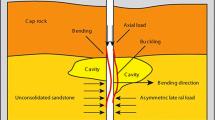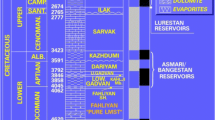Abstract
In the Gachsaran Formation, the casing pipes driven into a number of wells have collapsed within a short span of time in one of the southwest fields of Iran. The casing collapse causes the loss of production wells and imposes steep costs. One of the main causes of these damages is the movement of the ductile salt layers, resulting in high horizontal stresses. In this study, these stresses were first determined with the help of a deep geomechanical model to examine the emergence of the collapse phenomenon, and then, the depth was determined with simulation software, as are the numerical values of stresses that have been able to overcome the yield stress of the casing and caused collapse. Finally, the study of the geomechanical model shows that the highest probability of collapse is at the depth of the Gachsaran Formation. Subsequently, by simulating the depth of the formation, the study shows that the highest numerical values of the applied stresses were related to the Gachsaran layers 2–4, which have the highest volume of salt units.

(maps adapted from Hosseini et al. 2015)











Similar content being viewed by others
References
Bahroudi, A., & Koyi, H. A. (2004). Tectono-sedimentary framework of the Gachsaran Formation in the Zagros foreland basin. Marine and Petroleum Geology, 21, 1295–1310.
Chi, E., Zhao, M., Liu, J., & Kang, Q. (2015). Numerical modeling of rock fracture and Fragmentation under impact loading using discrete element method. Advances in Mechanical Engineering, 7(6), 1–5.
Cook, J., Frederiksen, R. A., Hasbo, K., Green, S., Judzis, A., Martin, J. W., et al. (2007). Rocks matter: ground truth in geomechanics. Oilfield Review, 19(3), 36–55.
Farsimadan, M., Ahmadi, M., Ahangari, K., & Dashtbozorgi, J. (2014). Determine the range of in situ stresses around damaged wells in Marun oil Field. Irianian Petroleum Geology Journal, 6, 1–21.
Feng, Y., Jones, J.F., & Gray, K.E. (2015). Pump-in and flow-back tests for determination of fracture parameters and in situ stresses. In AADE national technical conference and exhibition, AADE-15-NTCE-35.
Fjaer, E., Holt, R. M., Horsrud, P., Raaen, A. M., & Risnes, R. (2008). Petroleum related rock mechanics (2nd ed.). Amsterdam, Netherlands: Elsevier.
Gholami, R., Rasouli, V., Aadnoy, B., & Mohammadi, R. (2015a). Application of in situ stress estimation methods in wellbore stability analysis under isotropic and anisotropic conditions. Journal of Geophysics and Engineering, 12, 657–673.
Gholami, R., Rasouli, V., Aadnoy, B., & Mohammadnejad, M. (2015b). Geomechanical and numerical studies of casing damages in a reservior with solid production. Rock Mechanics Rock Engineering, 49, 1441–1460.
Goodman, R. E. (1989). Introduction to Rock Mechanics, second edition. ISBN-13: 978-0471812005, pp. 202–217, 250–256.
Gorjian, M., Memarian, H., Moosavi, M., & Mehrgini, B. (2012). Dynamic properties of anhydrites, marls and salts of the Gachsaran evaporitic formation, Iran. Journal of Geophysics and Engineering, 10(1), 015001.
Hosseini, E., Neshat Ghojogh, J., & Habibnia, B. (2015). Characterization of fractures of Asmari Formation by using image logs, case study: Marun Oilfield. American Journal of Oil and Chemical Technologies, 3(5), 45–47.
Jandakaew, M. (2007). Stress-path dependency of rock salt. In Proceeding of the first Thailand symposium on rock mechanics (pp. 171–188). Greenery Resort, Khao Yai, Nakhon Ratchasima: Suranaree University of Technology.
Jinga, L., & Hudson, J. A. (2002). Numerical methods in rock mechanics. International Journal of Rock Mechanics and Mining Sciences, 39, 409–427.
Liang, E., Li, Z., Han, Y., Li, G., & Guo, P. (2013). Analysis on collapse strength of casing wear. Chinese Journal of Mechanical Engineering, 26(3), 613–619. https://doi.org/10.3901/CJME.2013.03.613.
Lin, W., Yamamoto, K., Ito, H., Hideki Masago, H., & Kawamura, Y. (2008). Estimation of minimum principal stress from an extended leak-off test onboard the Chikyu drilling vessel and suggestions for future test procedures. Scientific Drilling. https://doi.org/10.2204/iodp.sd.6.06.2008.
Liu, X., Yang, X., & Wang, J. (2015). A nonlinear creep model of rock salt and its numerical implement in FLAC3D. Advances in Materials Science and Engineering. https://doi.org/10.1155/2015/285158.
Lu, Z., Wan, L., Zeng, Q., Zhang, X., & Gao, K. (2017). Numerical simulation of fragment separation during rock cutting using a 3D dynamic finite element analysis code. Advances in Materials Science and Engineering. https://doi.org/10.1155/2017/3024918.
Marandi, M., Jahani, D., Uromeihy, A., & Karimpour Reihan, M. (2017). Analysis of structure and textures of anhydrite mineral in Gachsaran Formation in Gotvand Area, Iran. Open Journal of Geology, 7, 1478–1493.
Mehrgini, B., Memarian, H., Maurice, B., Dusseault, M. B., Ali Ghavidel, A., & Heydarizadeh, M. (2016). Geomechanical characteristics of common reservoir caprock in Iran (Gachsaran Formation), experimental and statistical analysis. Journal of Natural Gas Science and Engineering. https://doi.org/10.1016/j.jngse.2016.07.058.
Memari, A. (2013). Evaluation of surface subsidence in one of Iran’s oil fields using INSAR technique. American Journal of Oil and Chemical Technologies, 1(4), 9–17.
Metwally, I. M. (2017). Three-dimensional nonlinear finite element analysis of concrete deep beam reinforced with GFRP bars. HBRC Journal, 13(1), 25–38.
Motamedi, M., Sherkati, S., & Sepehr, M. (2012). Structural style variation and its impact on hydrocarbon traps in central Fars, southern Zagros folded belt, Iran. Journal of Structural Geology, 37, 124–133.
Nikolić, M., Roje-Bonacci, T., & Ibrahimbegović, A. (2016). Overview of the numerical methods for the modelling of rock mechanics problems. Technical Gazette, 23, 627–637. https://doi.org/10.17559/TV-20140521084228.
Parvizi, S., Kharrat, R., Asef, M. R., Jahangiry, B., & Hashemi, A. (2015). Prediction of the shear wave velocity from compressional wave velocity for Gachsaran Formation. Acta Geophysica, 63(5), 1231–1243.
Rolf, B., Mohammed, W., & Mohsen, P. (2006). A preliminary study of casing collapse in Iran. Hydroquest report. Houston: Schlumberger Oil Company.
Sepehri, M., Apel, D. B., & Szymanski, J. (2013). Full three-dimensional finite element analysis of the stress redistribution in mine structural pillar. Powder Metallurgy & Mining. https://doi.org/10.4172/2168-9806.1000119.
Slota-Valim, M. (2015). Static and dynamic elastic properties, the cause of the difference and conversion methods-case study. Oil and Gas Institue-National Research Institute, NAFTA-GAS. https://doi.org/10.18668/NG2015.11.02.
Tabaeh Hayavi, M., & Abdideh, M. (2016). Estimation of in situ horizontal stresses using the linear poroelastic model and minifrac test results in tectonically active area. Russian Journal of Earth Sciences. https://doi.org/10.2205/2016ES000576.
Tang, S. B., Huang, R. Q., Tang, C. A., Liang, Z. Z., & Heap, M. (2017). The failure processes analysis of rock slope using numerical modelling techniques. Engineering Failure Analysis. https://doi.org/10.1016/j.engfailanal.2017.06.029.
Velilla, J., Fontoura, S., Inoue, N., & Anjos, J. (2015). Numerical Modelling of Casing Integrity in Salt Layers Including the Effects of Dissolution and Creep. In 49th U.S. Rock Mechanics Symposium. San Francisco, California: American Rock Mechanics Association. ARMA-2015-347.
Wittke, W. (2014). Rock mechanics based on an anisotropic jointed rock model. ISBN: 978-3-433-03079-0. https://doi.org/10.1002/9783433604281.
Zhang, H., Sun, B., Yan, G., Wang, Z., & Huang, M. (2016). Distribution laws and effects analysis of casing external pressure taking elastic parameters matching into account. Petroleum, 2(1), 108–115. https://doi.org/10.1016/j.petlm.2015.11.005.
Zhong, L., Cong, H., Wang, S., Zhao, D., Wang, Z., & Yang, G. (2008). Deep salt formation wells successfully drilled with integrated in tahe oilfield. In IADC/SPE Asia Pacific Drilling Technology Conference and Exhibition. Jakarta, Indonesia: Society of Petroleum Engineers. https://doi.org/10.2118/115208-MS.
Zoback, M. (2010). Reservior Geomechanics. Cambridge: Cambridge University Press.
Acknowledgments
The authors thank the National Iranian South Oil Company for their help and financial support for data and software.
Author information
Authors and Affiliations
Corresponding author
Rights and permissions
About this article
Cite this article
Hedayatikhah, S., Abdideh, M. 3D Geomechanical Modeling of Casing Collapse in Plastic Formations (Cap Rock of Hydrocarbon Reservoir). Nat Resour Res 28, 273–286 (2019). https://doi.org/10.1007/s11053-018-9386-3
Received:
Accepted:
Published:
Issue Date:
DOI: https://doi.org/10.1007/s11053-018-9386-3




